
German Bee Sting Cake (Bienenstich) with this easy recipe guide
Explore the world of authentic German Bee Sting Cake, a traditional dessert. It combines sweet sophistication with rich culinary heritage. This Bienenstich recipe brings German bakery magic into your kitchen, turning simple ingredients into an extraordinary treat.
The German Bee Sting Cake is a standout dessert. It has a golden honey-almond topping and a smooth vanilla custard filling. Unlike complex pastries, this authentic German dessert is easy to make. It requires basic baking skills and a passion for creating something special.
Table of Contents
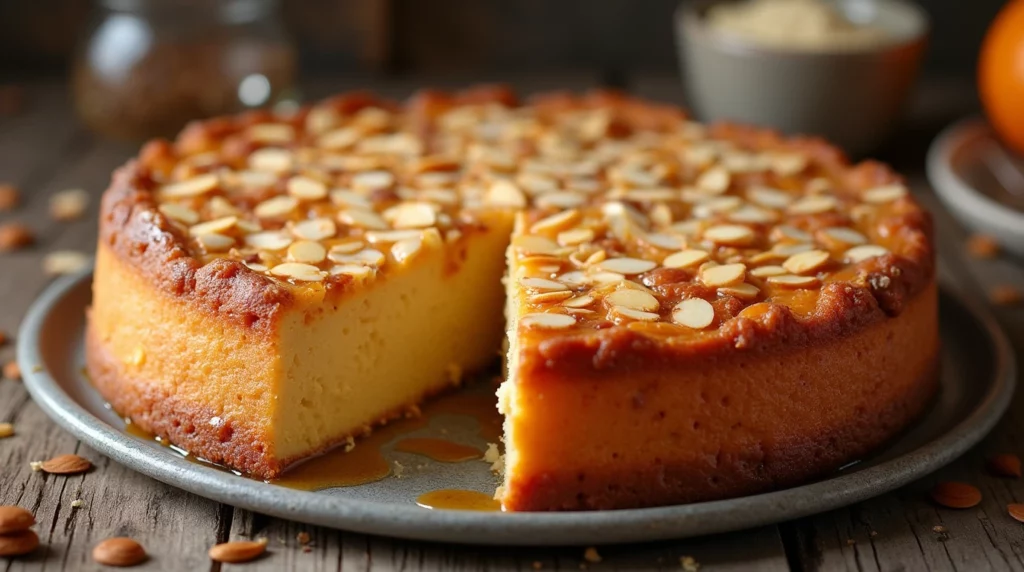
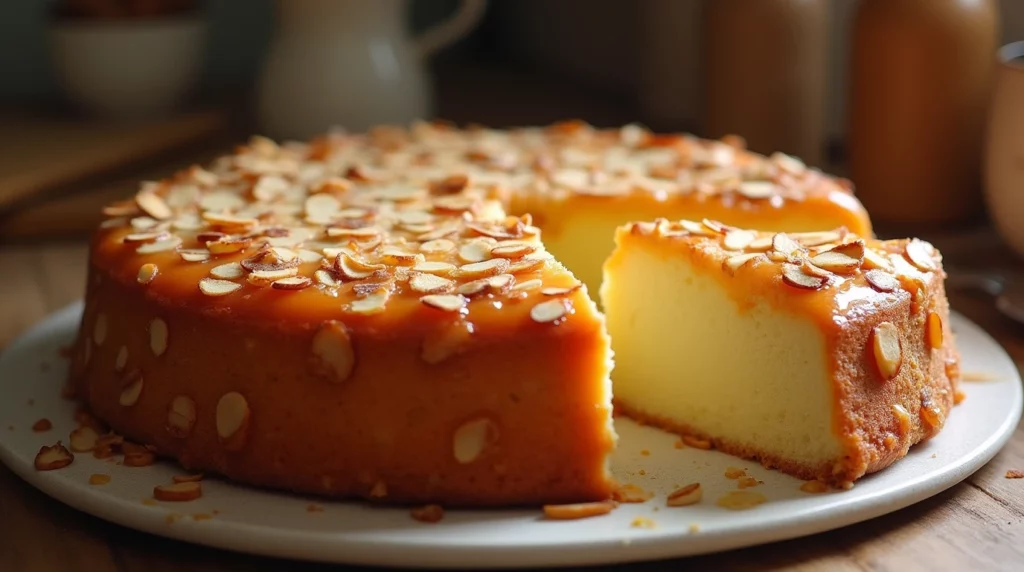
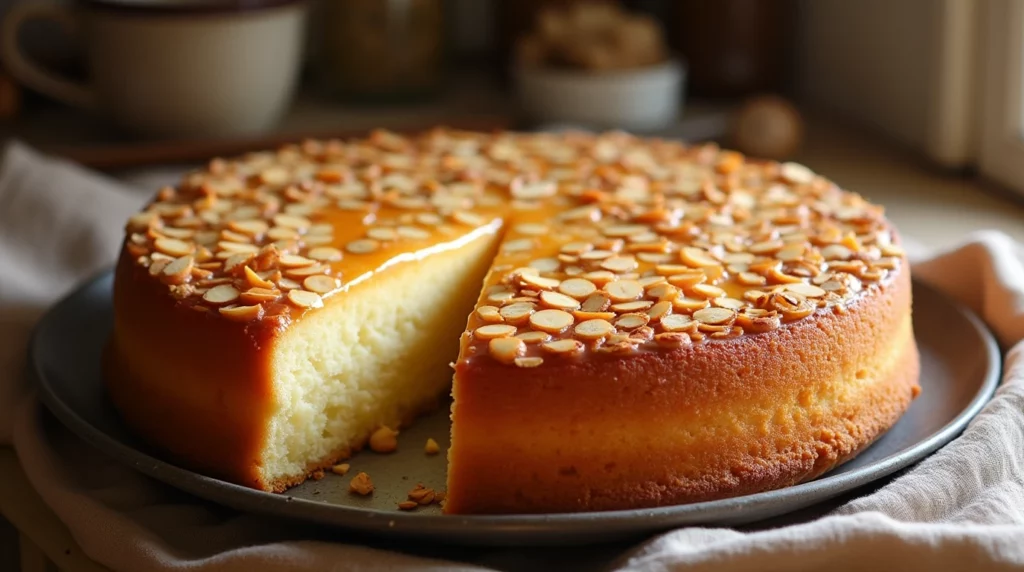
Understanding the History and Origins of German Bee Sting Cake
The Bienenstich, or Bee Sting Cake, is a sweet treat from German baking traditions. It has a long history filled with creativity, loved by food enthusiasts everywhere.
The Medieval Legend Behind Bienenstich
A medieval legend tells of a German village defending itself against raiders. Bakers threw beehives at the attackers, winning the battle. This victory led to the creation of the Bienenstich cake.
- The name Bienenstich literally translates to “bee sting”
- Legend suggests the cake was created to celebrate a successful town defense
- The honey topping symbolizes the bees used in the legendary attack
Traditional Significance in German Baking
In German baking, the Bienenstich is more than a dessert. It connects people to their cultural heritage. Each cake tells a story of local ingredients and family recipes.
Regional Variations Across Germany
German cakes, like the Bienenstich, show great diversity. Each region puts its own spin on this classic:
| Region | Unique Characteristic |
|---|---|
| Bavaria | Richer custard filling |
| Black Forest | Additional almond layer |
| North Germany | Lighter honey glaze |
The Bienenstich keeps growing, blending old German baking with new ideas.
Essential Ingredients for Perfect Bienenstich
Making a real German Bee Sting Cake needs the right Bienenstich ingredients. These ingredients make the cake’s flavors rich and traditional. The secret to this cake’s charm is in its top-notch parts.
The main Bienenstich ingredients fall into three groups:
- Cake Base Ingredients
- Honey Almond Topping Components
- Vanilla Custard Filling Elements
| Category | Key Ingredients | Recommended Quality |
|---|---|---|
| Cake Base | Flour, Fresh Yeast, Eggs, Butter | High-protein bread flour, Fresh active dry yeast |
| Honey Almond Topping | Honey, Sliced Almonds, Butter, Sugar | Pure wildflower or acacia honey |
| Custard Filling | Heavy Cream, Vanilla, Egg Yolks, Sugar | Madagascar vanilla beans or pure extract |
Choosing the right German cake ingredients is key. Freshness is crucial. Local bakers say using room-temperature ingredients is best for texture and taste.
“The secret to an exceptional Bienenstich is not just the recipe, but the quality of ingredients you choose.” – German Baking Tradition
For the best honey almond topping, use raw honey and lightly toasted almonds. This brings out their flavors. Each part is important for the cake’s unique taste.
Kitchen Tools and Equipment You’ll Need
To make a delicious Bee Sting Cake, you need the right tools. Whether you’re experienced or new to baking, the right gadgets can help a lot. They make your baking journey more fun and successful.
Before we start the recipe, let’s look at the key tools for making this classic German dessert.
Basic Baking Equipment
Every home baker needs these basic kitchen gadgets:
- 9-inch round cake pan
- Electric mixer or stand mixer
- Mixing bowls (various sizes)
- Measuring cups and spoons
- Rubber spatula
- Wire cooling rack
Specialized Tools for Best Results
For a better Bee Sting Cake, use these specialized tools:
| Tool | Purpose |
|---|---|
| Pastry brush | Applying honey glaze precisely |
| Kitchen scale | Ensuring accurate ingredient measurements |
| Offset spatula | Smooth filling and topping application |
| Candy thermometer | Monitoring caramel temperature |
Alternative Equipment Options
If you’re missing some tools, don’t worry. You can find substitutes:
- No pastry brush? Use the back of a spoon
- Missing a stand mixer? A hand mixer or whisk works perfectly
- Lack an offset spatula? A standard knife can help spread fillings
“The right tools transform good baking into great baking.” – Professional Pastry Chef
Making the Classic German Bee Sting Cake Base
Making the perfect Bienenstich cake base begins with a traditional yeast dough recipe. German cake layers need patience and precision for that light and fluffy texture. The yeast dough is the key to this beloved dessert.
First, gather your ingredients for the Bienenstich cake base:
- All-purpose flour (500g)
- Active dry yeast (2 1/4 tsp)
- Lukewarm milk (250ml)
- Granulated sugar (75g)
- Unsalted butter (100g)
- Large eggs (2)
- Pinch of salt
To make the yeast dough, you need to watch the temperature and technique closely. Warm ingredients are best for yeast activation. Start by mixing yeast with lukewarm milk and a bit of sugar. Wait 10 minutes for it to get frothy and bubbly.
| Step | Temperature | Duration |
|---|---|---|
| Yeast Activation | 100-110°F | 10 minutes |
| First Rise | 80-85°F | 1-1.5 hours |
| Final Rise | 75-80°F | 45-60 minutes |
Kneading is key for gluten development and a smooth dough. Mix the ingredients until the dough is soft and bounces back. Let it rise in a warm, draft-free spot until it doubles.
“The secret to a perfect German cake layer is patience and understanding the delicate nature of yeast dough.” – Traditional German Baking Wisdom
Pro tip: Use fresh yeast and handle the dough gently. This will help keep its delicate structure. You’ll get a light, airy Bienenstich cake base ready for your filling.
Creating the Signature Honey Almond Topping
The honey almond topping turns a simple cake into the famous Bienenstich. It adds a rich, golden crunch that’s key to this German dessert. Making the perfect caramelized nut topping needs careful attention and the right ingredients.
Selecting the Right Honey
Choosing the right honey is key for a true Bienenstich crust. Look for these qualities:
- Local wildflower honey for deeper flavor complexity
- Pure, unprocessed varieties with robust golden color
- Mild to medium intensity for balanced sweetness
Preparing Almonds for Caramelization
Getting your honey almond topping right depends on how you prepare the almonds. Here are some expert tips:
- Select blanched, sliced almonds for uniform texture
- Pat almonds dry to ensure crisp caramelization
- Toast almonds lightly before adding honey to enhance nutty flavor
Mastering Caramelization Technique
Getting the perfect golden-brown caramelized nut topping is all about heat control. Slow, steady heat turns sugar and honey into a glossy, crunchy layer. This is what makes the Bienenstich’s signature texture.
*Pro tip: Watch the caramelization closely – seconds can make the difference between perfect golden brown and burnt sugar!*
The trick is to keep the heat medium and stir constantly. This way, you’ll get a uniform, glistening honey almond topping. It will make your Bienenstich truly stand out.
Preparing the Rich Vanilla Custard Filling
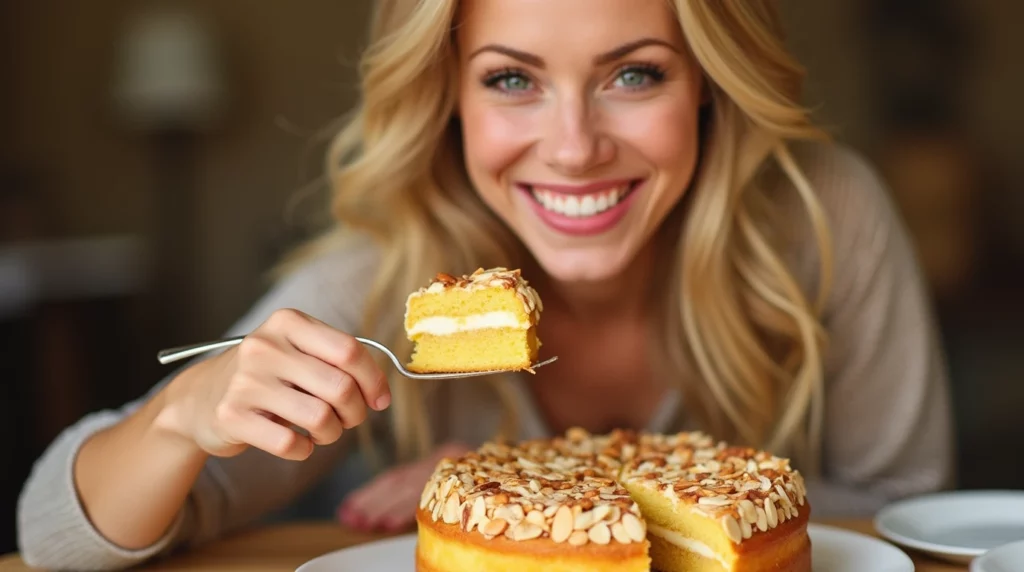
The heart of any authentic Bienenstich cake is its creamy vanilla custard filling. This German cake filling needs precision and careful technique. It must have the perfect smooth texture that makes Bienenstich cream so irresistible.
Creating an exceptional vanilla custard recipe starts with choosing high-quality ingredients. The key components include:
- Fresh whole milk
- Egg yolks
- Granulated sugar
- Pure vanilla extract
- Cornstarch
The preparation method is crucial for a rich, velvety texture. Start by whisking egg yolks with sugar until they become pale and creamy. Then, add cornstarch to prevent lumping.
“The secret to perfect German cake filling is patience and constant stirring.” – Traditional German Baking Wisdom
When heating the custard, use low to medium heat and stir constantly. This prevents scorching and ensures a silky smooth consistency. The ideal temperature for Bienenstich cream should be between 170-175°F.
| Ingredient | Quantity | Purpose |
|---|---|---|
| Whole Milk | 2 cups | Creates creamy base |
| Egg Yolks | 4-5 | Provides richness |
| Vanilla Extract | 2 tsp | Enhances flavor |
| Cornstarch | 3 tbsp | Thickens custard |
Pro tip: After cooking, immediately transfer the custard to a clean bowl. Cover the surface with plastic wrap to prevent a skin from forming. Refrigerate until completely chilled before using in your Bienenstich cake.
Assembly Tips and Techniques
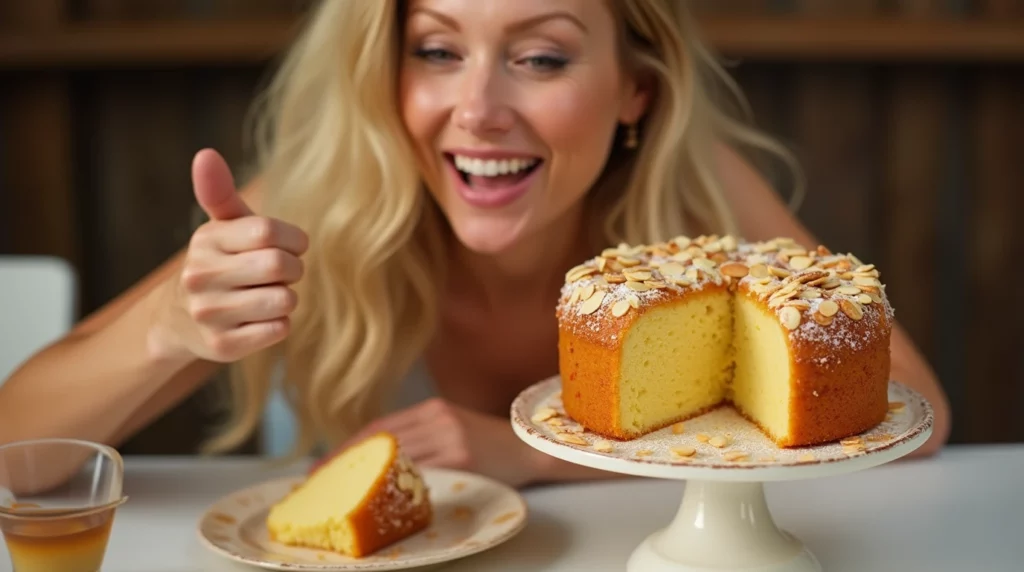
Mastering cake assembly techniques is key to making the perfect German Bee Sting Cake. Professional baking needs precision and attention to detail in layering.
Layering the Components with Expertise
For a successful layered dessert, start with well-prepared components. Follow these steps for the best results:
- Ensure cake layers are completely cooled before assembly
- Use a cake turntable for even and professional spreading
- Apply a thin crumb coat to stabilize the cake structure
- Chill layers between filling and topping applications
Temperature and Timing Considerations
Temperature control is crucial in cake assembly. Chill the custard filling to about 40°F to keep its shape. Use room temperature ingredients for smoother layers.
| Component | Ideal Temperature | Preparation Time |
|---|---|---|
| Cake Base | Room Temperature | 30-45 minutes cooling |
| Vanilla Custard | 35-40°F | 2-3 hours chilling |
| Honey Almond Topping | Warm (110-120°F) | 15-20 minutes preparation |
Professional Finishing Touches
Make your Bee Sting Cake look like it came from a bakery with these tips:
- Use a sharp serrated knife for clean cake cuts
- Smooth custard edges with an offset spatula
- Garnish with sliced almonds for elegant presentation
- Dust lightly with powdered sugar for a refined look
“The difference between a good cake and a great cake is in the details of assembly.” – Professional Pastry Chef
By using these cake assembly techniques, you’ll make a Bee Sting Cake that looks and tastes like a pro’s.
Storage and Serving Recommendations
Keeping your German Bee Sting Cake fresh is key. Its delicate texture and flavor need special care. This ensures it stays true to its German roots.
Serving German desserts like Bienenstich is all about temperature and how you present it. Serve the cake at room temperature. This brings out its custard filling and honey-almond topping.
Storage Guidelines
- Refrigerate the cake in an airtight container
- Consume within 2-3 days for optimal freshness
- Cover with plastic wrap to prevent moisture loss
Presenting Bienenstich is an art. Use a sharp, clean knife to create precise slices. Clean the blade between cuts to keep each slice looking perfect.
Serving Suggestions
- Remove from refrigerator 30 minutes before serving
- Pair with a light coffee or German white wine
- Garnish with fresh berries or mint leaves
“The secret to a perfect Bienenstich lies not just in its preparation, but in its careful presentation and storage.” – German Baking Experts
For the best experience, serve your Bee Sting Cake on a beautiful plate. Choose one that highlights its golden crust and creamy filling. Your guests will love the effort you put into both taste and presentation.
Common Troubleshooting Tips
Baking a delicious Bee Sting Cake can be tough, but with the right tips, you can fix common problems. Knowing how to solve cake texture issues is crucial. It helps you make a dessert that wows everyone.
Addressing Texture Challenges
Cake texture problems can ruin your baking. Here are some expert tips to fix common issues:
- Dry cake: Reduce baking time by 2-3 minutes and check internal moisture
- Dense bottom layer: Ensure proper ingredient temperature and mixing technique
- Uneven rise: Verify oven calibration and use fresh leavening agents
Preventing Baking Mistakes
Climate-adjusted baking needs careful attention. Here are ways to avoid common errors:
- Measure ingredients precisely using weight measurements
- Allow ingredients to reach room temperature before mixing
- Avoid opening the oven door during initial baking stages
Climate Adaptation Techniques
Different environments affect your baking. Humidity and altitude are key factors in cake making:
- High humidity: Reduce liquid ingredients by 1-2 tablespoons
- High altitude: Decrease sugar slightly and increase flour
- Low temperature environments: Extend proofing time for better texture
“Mastering baking is about understanding your ingredients and environment” – Professional Pastry Chef
By using these baking troubleshooting tips, you can turn cake disasters into culinary successes.
Recipe Variations and Modern Twists
German bakers are making the classic Bienenstich cake their own. They turn traditional recipes into exciting new desserts. Now, they mix old favorites with fresh ideas.
Today’s pastry chefs are making big changes to this beloved dessert. They’re trying new things:
- Chocolate-infused Bienenstich with dark chocolate custard filling
- Seasonal fruit variations featuring berries or citrus cream
- Miniature Bienenstich cupcakes for individual servings
- Deconstructed Bienenstich trifle with layered components
German bakeries are adding their own special touches to the classic recipe. Some are trying:
| Variation Style | Unique Ingredient | Flavor Profile |
|---|---|---|
| Black Forest Bienenstich | Kirsch-soaked cherries | Rich, fruity |
| Bavarian Cream Bienenstich | Vanilla bean custard | Smooth, classic |
| Nutty Alpine Version | Hazelnut praline | Robust, nutty |
Modern bakers are embracing innovation while respecting the cake’s rich culinary heritage. They show how traditional German desserts can grow and stay true to their roots.
“Innovation in baking is about honoring tradition while daring to reimagine classic flavors” – German Pastry Chef Association
Home bakers can try their own Bienenstich twists. They can play with fillings, nuts, or spices. This keeps the honey and almond taste but adds something new.
Conclusion
Learning to make Bee Sting Cake is more than just baking. It’s a dive into traditional baking skills that connect you to centuries of history. Each layer of the cake tells a story of German baking tradition.
This journey invites home bakers to explore rich flavors and techniques passed down through generations. It’s a way to connect with German baking heritage.
The process of making this cake is more than following a recipe. It’s a culinary cultural exchange that connects kitchens worldwide. By baking authentic German desserts, you’re preserving a piece of cultural history.
This history brings people together through the universal language of food. It’s a way to share and celebrate different cultures.
Whether you’re an experienced baker or just starting, Bee Sting Cake is a great place to begin. It challenges you to learn new skills and try traditional techniques. Making this cake is a way to create something special.
Sharing this dessert with friends and family makes cooking a meaningful experience. It turns a simple task into a way to connect and share culture.
Every slice of Bee Sting Cake celebrates culinary craftsmanship. It shows the beauty of keeping traditional recipes alive. It invites you to explore the world of international baking, one delicious recipe at a time.
Frequently Asked Questions about German Bee Sting Cake (Bienenstich)
What is a German Bee Sting Cake (Bienenstich)?
Why is it called Bee Sting Cake?
Is Bienenstich difficult to make at home?
Can I make substitutions in the traditional recipe?
How long does Bee Sting Cake stay fresh?
Are there regional variations of Bienenstich?
Can I make Bienenstich ahead of time?
Is Bienenstich suitable for special diets?
Share Your Experience with Our Recipe!
There are no reviews yet. Be the first one to write one.



